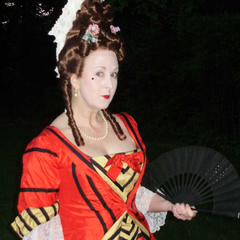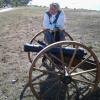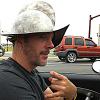Captain Twill
Academic Fight Circle, Research, Share, Discuss & Debate Maritime History.
1,566 topics in this forum
-
- 10 replies
- 2.2k views
http://www.boston.com/news/local/new_hamps..._auction_in_nh/ LONDON—"Fish for dinner." Not surprising for a sailor, perhaps, but the laconic observations of George Hodge, who went to sea in 1790, have stirred interest in his native land. Hodge's self-illustrated journal, recording an adventurous life as a sailor and a prisoner of the French during the Napoleonic Wars, is being offered at auction Saturday by Northeast Auctions in Portsmouth, New Hampshire. The auctioneer estimates the journal, a rare record of the life of an ordinary sailor, will fetch US$35,000 to US$50,000.
 Last reply by Red Cat Jenny,
Last reply by Red Cat Jenny, -
- 14 replies
- 3.1k views
"As for using period patterns, some are good but a lot of them do not have the neck-back shoulder seam at the proper angle or at the right height. It must be cut for each person individually. None of the clothing for women or men should have a shoulder seam on top of the shoulder. Especially if it is a military coat. No seams to rub with all the gear they carried on their shoulders..Makes sense. The front continued up and over the shoulders and joined a hand width down. This fitting made that seam to fall almost on a bias and helped it to give when the arms are raised to fire a weapon." Also very much would like to disagree about the shoulder seams on the men's coat…
-
- 8 replies
- 1.6k views
I was reading something last year or so about how fatiguing the constant use of the pumps were and how this might make men more susceptible to illness (which might well be a lot of bunk since many of the seaman's jobs were strenuous, although probably none so on-going as this one). Anyhow, this got me all interested in pumps and leaks vis-a-vis my research and so when I find something moving along that heading, I take note of it. So I thought others might enjoy this bit about this under-discussed aspect of seafaring from Nathaniel Boteler[butler]'s Dialogues, first published in 1685. The edition I'm reading was edited by W. G. Perrin and published by the Navy Records Soci…
Last reply by capn'rob, -
- 16 replies
- 1.8k views
As some may know, I have been in love with Francois Desportes outfit in his 1699 self portrait. I finally saved up enough to have a kit based on his made for me (don't sew much myself). I received my wool late 1600s style justaucorps and just today received my sleeved waistcoat. I have to say, both pieces are just amazing!!!!!!! Next up, I receive the breeches (note the pocket on the thigh) and a small buff civilian style sword belt. Check it out!
Last reply by Bos'n Cross, -
- 10 replies
- 5.4k views
Following my comments in the Tartan Shortcoat thread, I have been tabulating the colours and fabrics mentioned in various sources describing sailors' clothing of the 17/18th centuries. More often than not the garments are only listed, without description, but there are still plenty of more detailed descriptions available which might be enough for us to draw some conclusions about colours and fabrics. What follows is information culled from a variety of sources (listed more fully at the end), and some general points need to be made. I have ignored any mention of clothing which does not also list either fabric or colour. Most descriptions list fabric or colour, only a few l…
Last reply by Bos'n Cross, -
- 18 replies
- 2.2k views
I'm having a hard time finding info on spare "stuff" used for repairs. I've read that lead was used for patches and wooden pegs. We know that spare sails were around but where would this stuff be stored? Is there a book or website that references the ship stores? I'm kinda stuck....
Last reply by Bos'n Cross, -
- 24 replies
- 2.5k views
Yeah...yeah... this should be down in pyrate pop..... Or should it? OK.. this novel discusses the ruthlessness of Pyrates, in a happily graphic way... <as in... Pyrates were not nice...> In Pirate PoP... we have Pyrates as fun people that would be happily interesting to invite to your next beach party..... Is that what Pyrates were really like? I think Benchley did a good job of describing them... (in a novel or what...) SO.... do we keep telling fun storys about Noble gentlemen... their land stolen from them and they had to resort to Pyracy to recover their rightful territory (and get the girl)..... or do we want to look at the truth? Pyrates were despera…
-
Doing some research here: What kind of soap was used in England and Ireland? Was it lye based, soapweed, or something else?
 Last reply by Cheeky Actress,
Last reply by Cheeky Actress, -
- 5 replies
- 1.6k views
I was thinking today about windlasses and that got me thinking about a topic I really don't know much about. Anchors. And a little more detailed about what and how these monsterous iron hooks were kept attached to the ship. I once read somewhere (I'm not sure if this is right or not so please correct me if I am) that for every foot of water you have in depth you are supposed to have nearly 4 to 7 feet of line on the anchor cable. If that is the case then in roughly one hundred feet of water, you'd be looking at employing an anchor cable upwards of 700'. Ok so now what constitutes an anchor cable? I've seen the term cable in period refer to any large diameter line, roug…
Last reply by capn'rob, -
- 1 reply
- 757 views
Reading a bit on a favoured page, Myths of reenacting
-
- 3 replies
- 809 views
http://www.bmagic.org.uk/objects/1965T5099 Was looking up pc wig stands and ran across this, thought you might like a gander at it
 Last reply by Capt. Sterling,
Last reply by Capt. Sterling, -
- 10 replies
- 2k views
Most of us are familiar with the traditional watch-standing system of seven periods, namely: First watch: 8pm-12am Second or middle watch: 12am-4am Morning watch: 4am-8am Forenoon watch: 8am-12pm Noon watch: 12pm-4pm 1st dog watch: 4pm-6pm 2nd dog watch: 6pm-8pm But is this the same watch system that would have been used throughout the Golden Age? The oldest reference I know of to dog watches is from Falconer's Marine dictionary in 1783. He says that the watch "is always kept four hours by our British seamen, if we except the dog-watch between four and eight in the evening, that contains two reliefs, each of which are only two hours on deck." This agrees in eve…
 Last reply by MarkG,
Last reply by MarkG, -
- 10 replies
- 1.7k views
I thought I'd share some research I have been doing into period clothing. While looking at a Dutch Museum I came across this picture painted in 1682 by Thomas Heeremans [Dutch Painter, ca.1640-1697] It shows a scene of a port in 1682 (possibly a Dutch settlement in the New World somewhere). I have blown up sections of the picture for people to look at with regards to the clothing the sailors are wearing. There seems to be a mixture of short and long jackets and suprisingly most of the waistcoats seem to be short waist length ones rather than the thigh length ones we have come to associate with the era. There is also a mix of different types of hat with very few actu…
 Last reply by PoD,
Last reply by PoD, -
- 8 replies
- 1.1k views
I don't know if this has been posted before, but here for your viewing pleasure: http://www.gutenberg.org/files/24882/24882-h/24882-h.htm I hope some will find this helpful, enjoy. Bo
 Last reply by Daniel,
Last reply by Daniel, -
- 13 replies
- 1.2k views
Ya know... thar I was at PiP... dressed in me workin' Buccaneer garb..... Blander than sh*t.... Hey... try to find any pictures of me... so I musta done something right....... Wot people really wore isn't that photographic.... Looks plainer than snot..... Cool... like I said/typed.... I mustta done something right.......
 Last reply by madPete,
Last reply by madPete, -
- 21 replies
- 1.6k views
Hey, everybody! How's it going? Great. Anyway, I wondered something about pieces of eight: Since they were milled and their value more or less standardized in 1732, were they commonly subdivided in to eight pieces (or two bits or four bits or whatever) before this time? I can't find any specific reference to a 'bit' nor can I find any information on the numismatic sites specifically indicating that pieces of eight were subdivided during the GAoP. I think it would be cool to know - the Archangel frequently plays hazard at events (I know we didn't do it much at PiP this year, but for some reason I kept going to bed early with my dice) and I think it would be cool to do a d…
 Last reply by Matty Bottles,
Last reply by Matty Bottles, -
- 7 replies
- 1.2k views
I have this vague impression that it was illegal to flog officers, but I don't recall where I found it. There's at least one 19th-century account of a naval officer being flogged, in Fraser's magazine, but the circumstance is exceptional. The admiral who ordered it was impaired by alcohol and brain damage, and went to great lengths to atone for it after he recovered his senses, while the author implies that the flogging was illegal but was carried out anyway because no one dared question orders. It's not clear whether the illegality lay in the victim being an officer, or the many other irregularities surrounding the case (such as the fact that the victim wasn't even ac…
Last reply by capn'rob, -
- 5 replies
- 784 views
so over time i've run across references that refer to people carrying credentials that say they are a property owner in such and such colony or a member of a parish or various other form of identification to keep them from being arrested as a run away indentured servant or other such inconveniences but i cannot find a written description or picture of one of these get out of jail free cards. anyone ever run across one of these various items?
 Last reply by LadyBarbossa,
Last reply by LadyBarbossa, -
- 4 replies
- 770 views
I think I read somewhere in Richard Henry Dana's Two Years Before the Mast that sailors (as opposed to officers, obviously) on the Pilgrim and the Alert were not allowed to talk to each other while they were on deck or aloft. The reason wasn't stated, although I can imagine that the officers might prefer not to have to shout over a lot of other people's voices when they needed to give an order. This would have been about 1835 or 1836. Was there a general rule of compulsory silence aboard sailing ships dating back to the 17th and 18th centuries? Or was the rule on Dana's ships limited to America, or to the 19th century, or both? I assume the pirates would not have ha…
 Last reply by Daniel,
Last reply by Daniel, -
- 5 replies
- 762 views
The book I'm currently reading, The Navy Surgeon; or Practical System of Surgery by John Atkins in 1742 has a chapter on the senses that is...well, it's really quite interesting. I would reprint the whole thing just to amaze some of you with how much they understood some things (and how far they had to go in other things). His description of human sight that really caught my attention because it contains a mix of period medicine, science and religion. To wit, "To a perfect Sight also, it's necessary Objects should keep the same Station and Distance; for Sight being the Rays of an Object painted on one point of the Retina, they are continually altering, in Sailing or Rid…
 Last reply by Mary Diamond,
Last reply by Mary Diamond, -
- 6 replies
- 772 views
Maybe this has already been discussed, but i found an on-line text of this I thought some here would enjoy. http://nationalhumanitiescenter.org/pds/becomingamer/economies/text5/williambyrddiary.pdf Check out the May 6 1709 entry for its mention of shipping loss. Here's some more bawdy entries: http://userpages.umbc.edu/~bouton/History101/ByrdIIDiary.htm Hope you enjoy the reading. Bo
 Last reply by Honour Bright,
Last reply by Honour Bright, -
- 7 replies
- 1.1k views
Pirate scholars, ahoy! When you have a chance, go over to http://www.slavevoyages.org/tast/database/search.faces. Click on "General Variables," then on "Voyage Outcome," then on "Particular Outcome of Voyage." Then on "Current Query," click "Select," scroll down, and check off all the pirate subcategories; I suggest the four that start "Captured by pirates or privateers," then the ones that say "Captured by pirates - slaves sold in the Americas by another ship," "Some slaves removed by pirates/privateers," "Either shipwrecked or captured by pirates before slaves taken aboard," and "Captured by Algerian pirates." Then click "search." You will come up with names and dat…
 Last reply by Daniel,
Last reply by Daniel, -
- 4 replies
- 686 views
In doing some research for a story I started writing way back before I got into pirate stuff I need some help, now that I'm older and have learned so much from here. I want to go back and start re-writing much of it, but I have some questions that I can't find answers to. Hoping someone here could help me out. 1. What type of English accent was prominet in Portsmouth? 2. How long would it take to sail from Portsmouth, England to Jamaica? 3. What was the area of the hold called where the animals were kept? 4. How many holds would a regular sailing ship have? 5. What were the usual dimensions of the Captain's cabin?
 Last reply by Rumba Rue,
Last reply by Rumba Rue, -
- 3 replies
- 696 views
Once again, in preparation for an even i ask for assistance....NO BUTT PASTE THIS TIME........... So sense im newer too the 17th century side of reenacting(thought admittedly the 17th is my FAVORITE fashion wise...except for that whole frilly restoration fluffy crap.......) So my friends, if you would be so kind as to lend me a few links to good sites and vendors.......of course ill look myself.....but i KNOW(....bagley.........) that some of you have beat me to it......i want a new hat...a tall one.......yup...........and a buff coat..........
Last reply by Bos'n Cross, -
- 13 replies
- 2k views
So now that PiP 09 is sadly over, I'm looking forward to Searles Raid - and the nice pair of riding bucket boots in my closet.... My personal research has turned up several examples of bucket boots holding on to fashion into the 1600s, even though shoes looked to be growing in popularity after the English Civil War. Anyway, my question to any 1660s clothing geeks, I mean historians.... Are leather bucket riding boots (not the pleather Jack Sparrow ones) right for the 1660s? Here is a painting I found from 1661 showing at least one dude in boots like mine. Next question, if they are okay, does anyone know of a supplier for boot hose? Thanks!
Last reply by Rats,










